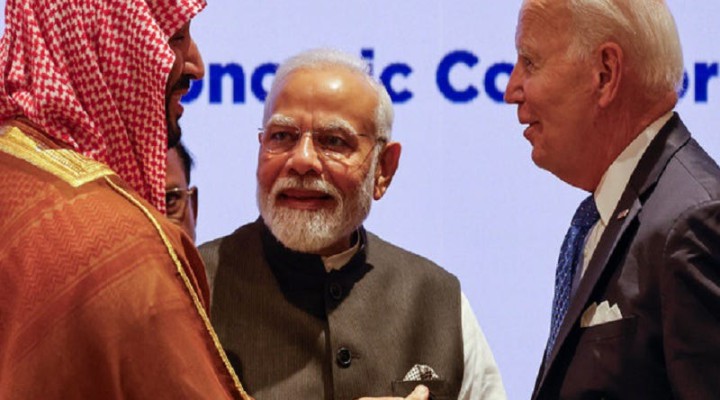Saudi Arabia Is Reaping The Geo-Economic Fruits Of Sino-US Competition

Through these three major developments over the past year that all directly arose from Vision 2030, MBS was able to do the seemingly impossible by reaping the geo-economic fruits of Sino-US competition in such a way that Saudi Arabia profits from both of them, Russia, India, and the EU at the same time.
Saudi Arabia is maximally benefiting from Sino-US competition as proven by three major developments this year thus far. First, China brokered the Saudi-Iranian rapprochement earlier this spring, which was followed by the second achievement of those two being admitted to BRICS as full members less than half a year later. The third move then came not even a month after that when the US invited Saudi Arabia to join the India-Middle East-Europe Economic Corridor (IMEC) at last weekend’s G20 Summit.
None of these would have happened had it not been for Crown Prince Mohammed Bin Salman’s (MBS) ambitious Vision 2030, which can be summarized as a combination of comprehensive reforms at home and geostrategic balancing abroad. To that end, he revolutionized his county’s society and sought to diversify from the economy’s dependence on energy exports in pursuit of the first goal, while the second was advanced by cultivating strategic ties with non-traditional partners like China, Russia, and Iran.
The latter was greatly aided by disputes between MBS and the US’ two most recent Democrat Administrations, which incentivized him to accelerate the pace of his country’s newfound geostrategic balancing act by more actively engaging with China in all respects. Obama’s clinching of the Iranian nuclear deal coupled with Biden’s criticism Saudi Arabia for its conduct in the Yemeni War and the death of Jamal Khashoggi ensured that ties with the US’ systemic Chinese rival would be prioritized by Riyadh.
To MBS’ credit, these relations continued growing in spite of the Saudi-US thaw under Trump and everything that the former American leader did to undermine Iran. This observation shows how sincere he was about implementing Vision 2030 since he could have easily decelerated the pace of this initiative or abandoned it completely during that time. Instead, he remained committed to cultivating strategic ties with China, which ultimately led to his country’s rapprochement with Iran.
That development was a game-changer since it simultaneously accomplished both of Vision 2030’s complementary goals: regional economic opportunities were unlocked together with cultivating strategic ties with what had hitherto been his country’s least likely partner anywhere in the world. China brokered this deal since the resultant regional economic integration processes align with the Belt & Road Initiative’s (BRI) envisaged community of common destiny for mankind.
Accordingly, the next natural step was to admit both of those former rivals into BRICS, which served the strategic geo-economic interests of that group’s RIC core. China foresees real-sector trade with Saudi Arabia one day being conducted largely through overland routes via the China-Central Asia-West Asia Economic Corridor whose southern branch passes through Iran. Russia, meanwhile, wants to incorporate Saudi Arabia into its North-South Transport Corridor (NSTC) with Iran.
Tangible progress was made in that direction late last month after the first-ever Saudi-bound Russian cargo train arrived in the Islamic Republic en route to the Kingdom via this multimodal corridor. As for the Indian dimension, bilateral trade and investment will predictably strengthen now that Saudi Arabia is a member of BRICS, but there’s more to it than just that. This actually laid the basis for those two to co-found IMEC last weekend alongside their shared Emirati, American, and European partners.
Had Saudi Arabia remained outside of BRICS, then it’s possible that the Kingdom might have been reluctant to join IMEC due to concern that this series of megaprojects could be perceived by China as competing with BRI, thus unnecessarily sowing distrust in their fast-moving strategic partnership. That could have in turn had the effect of either complicating Saudi Arabia’s balancing act if MBS still went through with it or making IMEC impossible seeing as how his country is its irreplaceable transit state.
The best possible middle ground was therefore reached whereby Saudi Arabia institutionalized its economic-financial cooperation with new non-traditional partner China in parallel with preemptively averting any potentially disproportionate dependence on the People’s Republic via IMEC. The latter also served to prevent the US from suspecting that Saudi Arabia’s rapprochement with Iran and membership in BRICS are aimed against it after Riyadh agreed to play an indispensable role in this Indo-EU corridor.
Through these three major developments over the past year that all directly arose from Vision 2030, MBS was able to do the seemingly impossible by reaping the geo-economic fruits of Sino-US competition in such a way that Saudi Arabia profits from both of them, Russia, India, and the EU at the same time. This outcome positions his Kingdom in the center of the global systemic transition to multipolarity, which imbues this comparatively young leader with outsized influence in shaping the emerging world order.
https://korybko.substack.com/p/saudi-arabia-is-reaping-the-geo-economic
 TheAltWorld
TheAltWorld 
One thought on “Saudi Arabia Is Reaping The Geo-Economic Fruits Of Sino-US Competition”